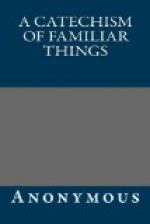The Aurora Borealis, or Northern Lights, a luminous appearance in the northern parts of the heavens, seen mostly during winter, or in frosty weather, and clear evenings; it assumes a variety of forms and hues, especially in the polar regions, where it appears in its perfection, and proves a great solace to the inhabitants amidst the gloom of their long winter’s night, which lasts from one to six months, while the summer’s day which succeeds it lasts in like manner for the same period of time.
Of what nature is the Aurora Borealis?
It is decidedly an electrical phenomenon which takes place in the higher regions of the atmosphere. It is somehow connected with the magnetic poles of the earth; and generally appears in form of a luminous arch, from east to west, but never from north to south.
Phenomenon, an
extraordinary appearance. The word is from
a Greek one, signifying,
to show or appear.
Magnetic, belonging to the magnet, or loadstone.
Luminous, bright, shining.
In what country is it seen constantly from October to Christmas?
In Siberia, where it is remarkably bright. On the western coast of Hudson’s Bay, the sun no sooner disappears, than the Aurora Borealis diffuses a thousand different lights and colors with such dazzling beauty, that even the full moon cannot eclipse it.
CHAPTER II.
CORN, BARLEY, PEARL BARLEY, OATS, RYE, POTATOES, TEA, COFFEE, AND CHOCOLATE.
What is Corn?
Corn signifies a race of plants which produce grain in an ear or head, fit for bread, the food of man; or the grain or seed of the plant, separated from the ear.
What is generally meant by Corn?
In this country, maize, or Indian corn, is generally meant; but, in a more comprehensive sense, the term is applied to several other kinds of grain, such as wheat, rye, barley, oats, &c.
Where was Corn first used?
It is uncertain. The Athenians pretend that it was amongst them it was first used; the Cretans, Sicilians, and Egyptians also lay claim to the same. From the accounts in the Bible, we find that its culture engaged a large share of the attention of the ancient Hebrews.
Culture, growth,
cultivation. Hebrews, the children of
Israel, the Jews
Who were the Athenians?
Inhabitants of Athens, the capital city of Greece.
Who were the Cretans?
The inhabitants of Crete, an island of the Archipelago.
Who were the Sicilians?
Inhabitants of Sicily, the largest island of the Mediterranean Sea, now a part of Italy, and separated from the mainland by the Strait of Messina.
Where do the Egyptians dwell?
In Egypt, a country of Africa. It is extremely fertile, producing great quantities of corn. In ancient times it was called the dry nurse of Rome and Italy, from its furnishing with corn a considerable part of the Roman Empire; and we are informed, both from sacred and profane history, that it was anciently the most fertile in corn of all countries of the world. The corn of Syria has always been very superior, and by many classed above that of Egypt.




